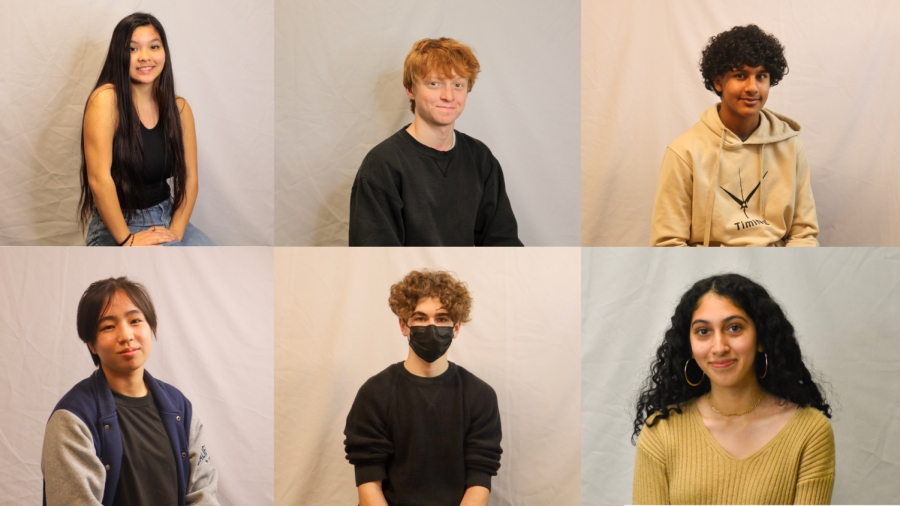Photos by Kalyani Puthenpurayil and Dahlia Schilling
Hair holds varying significance for these six students, from being an extension of their personality to a characteristic that others like to point out.
Hair down
Exploring the stories behind students' hair
March 23, 2023
Below are the experiences of six students’ who are navigating their hair journey, from learning how to deal with curly hair to dying it different colors to adopt a more interesting look that they identify more with.
Amrita Arun
As senior Amrita Arun entered her pre-teen years, she started noticing curls in her hair, which surprised her — she had had straight hair since she was born. She learned that her mother’s and grandmother’s hair had gone through the same change, which made her feel a connection to the both of them.
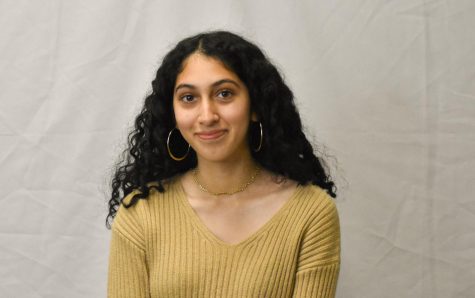
As her hair became increasingly frizzy, Arun grew concerned as she struggled to tame it and tie it into a ponytail. She avoided having her photo taken because seeing her pictures reinforced her insecurities surrounding her hair. Hoping to enjoy her hair more, Arun started to experiment with it more as she entered high school.
“I experimented with [my hair] a little bit more [partly] because I feel like people judge you pretty severely [based] on your looks,” Arun said. “Also being a young woman, you’re judged very harshly on your looks and it has a very direct correlation to your self esteem.”
When Arun saw peers and famous people with straight hair, it made her envious because it seemed that taking care of their hair was so much easier and effortless. As she finally came to terms that her hair would not be like that, she started looking at celebrities and influencers with curly hair on social media to find out how they dealt with it — if she could not have straight hair, she wanted to have nice curls like them. Still, while their hair sat in perfect, shiny curls, Arun’s hair stood up, her curls tousled and poofy, and their perfection seemed impossible for her to achieve.
Arun started watching YouTube videos on taking care of curls and scrolled through Pinterest, which are two major platforms in which she has “consum[ed] so much curly hair content.” Arun tried everything, from trying out different hairstyles during the day to braiding her hair at night to maintain the curl patterns and reduce frizziness. When quarantine hit during her sophomore year, Arun was able to spend more time experimenting with her hair, trying different lengths, experimenting with various protection methods, styling techniques, and sampling different products. She also watched YouTube videos by Black women on how they took care of their curly and coily hair, and Arun was able to apply some of their tips on her own hair, which had a thick and coarse texture.
Aruns says she has embarked on a journey that she believes will last a long time: her hair journey. Arun recognizes that this journey is still ongoing, and she still has bad hair days where she doesn’t feel like taking pictures. And while her curly hair is important to her identity, she views straight hair as easier to maintain, especially in today’s society, where people with straight hair seem to have it easier.
“Hairstyles, models, hair accessories, products — I think it’s very catered towards straight hair and straight hair is perceived as the beauty standard,” Arun said. “Every day, I see people with straight hair and I want to be like them. Throughout the years, I’ve noticed that my wanting [for] my hair to be like someone else’s has definitely reduced. But it’s an ongoing thing. People think it’s an on and off switch, but it’s not. It’s a constant struggle, but it definitely gets better and I’m so much happier. I see pictures of myself back then and I’m so proud of my hair now versus back then.”
Arun believes that others who are insecure about their hair can achieve a confidence and satisfaction similar to hers if they explore and learn more about their hair.
“It’s taken me four years to understand the depth of what curly hair is and how to take care of it,” Arun said. “I’ve had a really long battle with my hair [and] it means a lot to me. It’s a big part of my identity as a person.”
Arun says the curl community has also empowered her to wear her hair down regularly, something that she wouldn’t have done a few years ago. She encourages others to follow influencers with curly hair, as they are always willing to share all their hair tips, tricks, styles and products. Seeing how other people were loving their hair led Arun to love her hair.
“Hair journey on the x-axis, self confidence on the y-axis — it’s a straight line up,” Arun said.
Chandril Banerjee
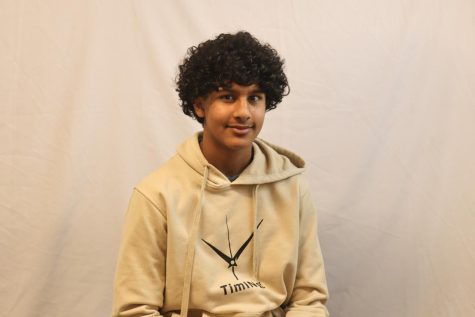
Standing between his older and younger brother with their wisps of wavy and straight hair, freshman Chandril Banerjee seemed to stand out with his short, springy curls. In family photos, all eyes appeared to be drawn to him — he was the odd one out.
When Banerjee meets up with family friends, he would often hear, “Your hair is so different,” which would raise the question of why he was classified as ‘different’ by them. That comment would shortly be followed by “Can I feel your hair?,” a question that Banerjee deems rather awkward. While he’s fine with people asking to touch it, he dislikes it when people touch his hair without his permission.
For the first 12 years of his life, Banerjee wanted straight hair like his older brother, because he thought it would allow him to fit in better within his family.
“I didn’t want to be different, I always looked up to my older brother and wanted to be like him,” Banerjee said. “[But] I didn’t cut [my hair] for eight months and people were telling me it looked good, so I just kept it.”
Banerjee’s hair type falls between his father’s straight hair and his mother’s tight curls, leaning more towards curly. However, his mother prefers to straighten her hair, causing Banerjee to be the only one with curls.
“My mom’s always wanted me to have straighter hair like my brothers,” Banerjee said. “My parents are always talking about how they don’t like my hair, but it is what it is. My hair is my hair and no one else can tell me what to do with it.”
Max Frazier
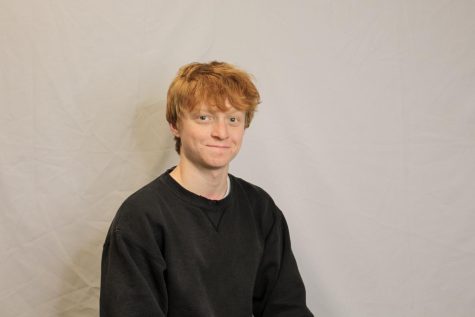
Vibrantly beaming from his head, junior Max Frazier immediately noticed the bright red strands of hair that lay atop his head in his baby photos. As he grew older, the color of his hair “calmed down a bit” yet it still remains a noticeable characteristic. For most people, his hair is the first thing that they notice.
“Sometimes people will be like, ‘Look at that ginger’ [and] I kind of feel targeted when they say stuff like that,” Frazier said. “At the same time, you wouldn’t really say ‘Oh, look at that black-haired person’ or ‘Look at that blonde person.’ It’s not really an insult or [something] I can take seriously, it’s just a little off-putting because that’s the only thing they notice about me.”
While he finds that others view red as less attractive compared to brown in terms of hair color, it doesn’t mean that he “lost the genetic lottery by having this hair” and has grown to accept his hair as a unique part of his identity over the years. Frazier says that his dad used to be a redhead as well, but it has turned brown over time, and is a phenomenon he has noticed with the relatives on his dad’s side. He has wondered what his hair would be like if it wasn’t brown, or whether he should dye it, however, he hasn’t made any drastic changes to it yet.
“I’ve had people telling me to dye [my hair] brown or dirty blonde, but I’m not a huge fan of dyeing my hair,” Frazier said. “I think they would find it interesting to see me with a different hair color, but I never seriously [considered] it.”
At school, Frazier stands out due to there only being a few redheads. However, his hair isn’t something that he thinks about a lot and doesn’t play a role in his day to day life.
“I don’t view myself with my red hair — I just view myself as who I am, like [my] personality,” Frazier said. “I think what’s more interesting is how others view my hair and how they just notice it before anything else and center everything around the fact that I am ginger.”
AJ

It was a dare from their brother that prompted senior AJ to chop off their long strands of dyed hair. When their hair was longer, they would occasionally dye it pink, purple and other colors — it was an outlet for experimentation and was more or less an afterthought due to a lack of attention they gave it.
But when Jiang arrived at school with their new hair, they faced some questions they didn’t expect.
“After I cut my hair, everyone else was like ‘What are your pronouns? What’s your gender identity?” Jiang said. “Before I cut my hair, I never thought about gender. No one ever asked me about gender. I had to think about what my hair meant to me a lot more because other people noticed it.”
Jiang says it’s inevitable to judge someone based on their appearance, especially their hair, and Jiang’s short hair seemed like an “anomaly” to others, which raised these questions. Although Jiang believes that outward appearance should not be used to make assumptions on a person’s gender, they find that it is often hard to avoid judgment due to the limited amount of time that people spend with others in social situations.
However, the new hair style became something that Jiang was able to identify more with because it served as a better representation of how they wanted to present themself to everyone. While Jiang’s hair started carrying more importance to them, it is still something that they do not take too seriously.
“It’s fun when people don’t treat their hair with so much reverence [and] they get to try out random styles,” Jiang said. “Experimentation [with hairstyles] is valuable because you may find that you like your original one. And then if you don’t, it’s just hair. In three months, it’s going to look exactly the same as it did before.”
Artem Savchenko
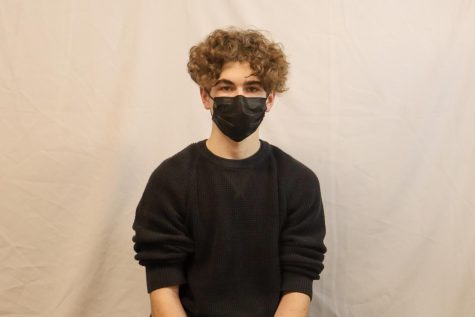
Interested classmates reach out their hands to touch sophomore Artem Savchenko’s hair which at the moment was cut short with an airplane design, and stripes along the sides, but longer on the top. This time he had decided on an airplane design taking inspiration from his dad who worked at an airplane company.
These types of haircuts weren’t uncommon as Savchenko always requested a Cristiano Ronaldo haircut from his barber in Ukraine. Savchenko often experimented with different designs along the side of his head.
But after having the same haircut for four years, and with the advice of those around him Savchenko eventually decided to try a new haircut after getting sick of constantly blow drying his hair. In hopes of switching it up, Savchenko decided to grow his hair longer. This time his dirty blonde hair came in forming loose curls, contrasting his typical straight and short hair.
While Savchenko has mixed feelings about this now curly hair, he prefers it over his freshman year haircut, which was longer and combed over.
“If I was someone other than me last year, considering the hair that I had, I wouldn’t have taken myself too seriously. It just looked kinda funny,” Savchenko said. “I feel like hair has a lot of power over how people see you.”
Getting his curls from his mom and grandmother Savchenko sometimes wishes he still had straight hair like his father. Since he feels, his curly hair can be unpredictable and often hard to deal with.
“I guess I understood that I don’t really have a choice and I’m not going to get a perm,” Savchenko said. “I wouldn’t say that I love it.”
Maya Pullara
Starting from a side part, long, straight locks of black hair fall down to sophomore Maya Pullara’s hips, the undersides sporting brown shades as a result of bleach. During icebreakers, one of her favorite fun facts about herself that she likes to tell others is that her wingspan is shorter than her hair length.

When Pullara moves, her hair swishes behind her, sometimes even accidentally hitting unsuspecting people. In seventh grade, she remembers often hitting the student behind her with her long braid when she turned, yet to Pullara, despite her hair “always flying everywhere,” it is something that she thinks suits her.
In second grade, Pullara went to get her hair trimmed. However, the stylist was dissatisfied with Pullara’s tangled hair and instead of trying to detangle it, the stylist cut her hair very short. Shocked by the sudden change that she had not agreed to, she made a decision to grow out her hair.
“Since then, my hair has just been growing,” Pullara said. “Also, in first grade, I was really obsessed with Rapunzel, and I thought if I grew my hair long enough, then I would get magic powers. That’s how it started, and then I just kept not cutting it from there.”
While keeping her hair long makes it interesting to some extent, Pullara sometimes struggles with perceiving it as a tedious extension of herself, having to wash it often since her scalp becomes oily if she does not wash it for a couple of days.
“Every once in a while, when you have black hair and it’s all really long, it feels the same,” Pullara said. “Over time, you get bored of it. You look at yourself in the mirror and you’re like, ‘I feel like it’s just a mop on my head, it’s got to be different.’”
Pullara remedied this boredom with extensive research on how to bleach her hair without damaging it, eventually bleaching it and then coloring it. To her, coloring her hair didn’t mean that her original hair looked bad — it’s because she wanted something new and to have fun with her looks.
“[My hair] makes me feel more confident,” Pullara said. “It kind of goes with me, it’s always flying everywhere and sometimes accidentally hits people in the face. It suits me.”

